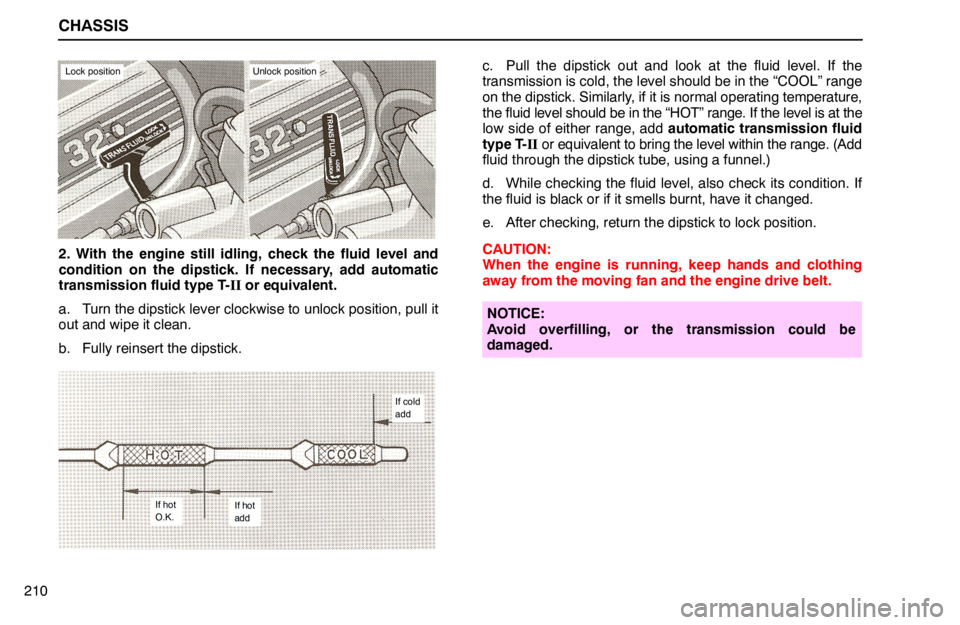belt lexus LS400 1994 Engine / 1994 LS400: CHASSIS
[x] Cancel search | Manufacturer: LEXUS, Model Year: 1994, Model line: LS400, Model: Lexus LS400 1994Pages: 14, PDF Size: 3.1 MB
Page 8 of 14

CHASSIS
210
Lock positionUnlock position
2. With the engine still idling, check the fluid level and
condition on the dipstick. If necessary, add automatic
transmission fluid type T-II or equivalent.
a. Turn the dipstick lever clockwise to unlock position, pull it
out and wipe it clean.
b. Fully reinsert the dipstick.
If hot
O.K.If hot
add
If cold
add
c. Pull the dipstick out and look at the fluid level. If the
transmission is cold, the level should be in the “COOL” range
on the dipstick. Similarly, if it is normal operating temperature,
the fluid level should be in the “HOT” range. If the level is at the
low side of either range, add automatic transmission fluid
type T-II or equivalent to bring the level within the range. (Add
fluid through the dipstick tube, using a funnel.)
d. While checking the fluid level, also check its condition. If
the fluid is black or if it smells burnt, have it changed.
e. After checking, return the dipstick to lock position.
CAUTION:
When the engine is running, keep hands and clothing
away from the moving fan and the engine drive belt.
NOTICE:
Avoid overfilling, or the transmission could be
damaged.
Page 12 of 14

CHASSIS
214Warning: The traction grade assigned to this tire is based on
braking (straight ahead) traction tests and does not include
cornering (turning) traction.
Temperature A, B, C − The temperature grades are A (the
highest), B, and C, representing the tire’s resistance to the
generation of heat and its ability to dissipate heat when tested
under controlled conditions on a specified indoor laboratory
test wheel. Sustained high temperature can cause the material
of the tire to degenerate and reduce tire life, and excessive
temperature can lead to sudden tire failure. The grade C
corresponds to a level of performance which all passenger car
tires must meet under the Federal Motor Vehicle Safety
Standard No. 109. Grades B and A represent higher levels of
performance on the laboratory test wheel than the minimum
required by law.
Warning: The temperature grade of this tire is established for
a tire that is properly inflated and not overloaded. Excessive
speed, underinflation, or excessive loading, either separately
or in combination, can cause heat buildup and possible tire
failure.
Tire selection
When replacing a tire, use only the same size and
construction as originally installed and with the same or
greater load capacity.
Using any other size or type of tire may seriously affect
handling, ride, speedometer / odometer calibration, ground
clearance, and clearance between the body and tires or snow
chains.Do not mix radial, belted, or conventional tires on your
vehicle.
It can cause dangerous handling characteristics, resulting in
loss of control. If you need to change from conventional tires
to radial tires or vice versa, replace them as a set.
INSTALLING SNOW TIRES AND
CHAINS
When to use snow tires or chains
Snow tires or chains are recommended when driving on
snow or ice.
On wet or dry roads, conventional or radial tires provide better
traction than snow or studded tires.
Snow tire selection
If you need snow tires, select the same size, construction
and load capacity as the original tires on your Lexus.
Do not use tires other than stated above. Since your vehicle
has radial tires as original equipment, make sure your snow
tires also have radial construction. Do not install studded tires
without first checking local regulations for possible restrictions.